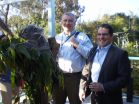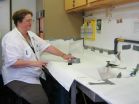(Press-News.org) (SALT LAKE CITY)--One of the big hurdles in bringing drugs to market is the difficulty of producing large enough quantities of potential compounds to conduct clinical trials. This is particularly true with compounds made by organisms, which usually are produced in exceedingly small amounts and are difficult to synthesize in the laboratory.
Researchers from the University of Utah College of Pharmacy have made an important stride in addressing those problems. In a study in ACS Synthetic Biology, researchers led by Eric W. Schmidt, Ph.D., professor of medicinal chemistry, describe an inventive technique that allowed them to take the genes that instruct a species of fungi to make large quantities of a native compound, and then "rewrite" them to make a different compound of potential therapeutic importance.
The study shows that one way to solve problems of synthesis of natural compounds is to figure out how an organism solves the problem itself, and then modify it for a particular use, according to Schmidt, who also holds the William R. Droschkey Endowed Chair in Pharmacy.
"In terms of drug discovery, there remains a large gap between finding a compound that's a potential drug and bringing it to market," he says, "so we've been looking at synthetic biology--how to write and rewrite genetic code to produce these compounds for us."
The compound the researchers synthesized was discovered at Wyeth Pharmaceuticals, now part of Pfizer Inc., in collaboration with another U College of Pharmacy faculty member, Louis R. Barrows, Ph.D., professor of pharmacology and toxicology. The compound was discovered because of its anti-tuberculosis properties. Barrows now is investigating the compound for potentially developing a new TB drug. (This work was highlighted in the Journal of Natural Products.)
To make the compound, the researchers used a fungus, Fusarium heterosporum, that naturally produces a chemical, called equisetin, in large quantities. Schmidt and the study's first author, Thomas B. Kakule, a University of Utah doctoral student in Medicinal Chemistry, deleted the equisetin-making pathway in the fungus. Then they gave two genes essential for synthesizing the chemical new instructions to make the anti-TB compound. Whereas it was previously a struggle to harvest enough of the anti-TB compound to even determine its chemical make-up, using the new system they were able to make enough of the compound to completely characterize the chemical and its anti-TB properties.
Another desirable feature, which was already built into the natural instructions for making equisetin, is that the fungal factory is highly controllable. The pathway is normally "off", but is turned "on" when the fungi is grown on corn grits, which can be bought at a natural food store. This inducible system means that they can make large amounts of nearly any compound whenever they choose, even those that are normally toxic to the organism.
"Basically, we exploited the native machinery that makes compounds in the fungus and redirected it to make the compound we wanted," Schmidt says. "I don't know why it hasn't been done before. We just felt that tapping into a native pathway that's in tune with the metabolism of the cell would have its advantages."
Although the research is in its early stages, the results with fungus represent an important step in merging genetic engineering with chemistry to answer basic questions about how natural compounds are made. The model for turning fungus into a factory for making an anti-TB compound can be applied to other organisms to address different diseases and issues.
INFORMATION:
The fifth tropical cyclone of the Northern Indian Ocean season formed in the Bay of Bengal as NASA's Terra satellite passed overhead and captured an image of the storm.
When Terra passed over Tropical Cyclone 5B on Nov. 6 at 05:05 UTC (12:05 a.m. EST), the MODIS instrument aboard took a visible image of the storm. The MODIS image showed a concentrated storm with strong thunderstorms circling tight around the center and in the northeastern quadrant.
By 1500 UTC (10 a.m. EST), Tropical Cyclone 5B was located near 13.4 north latitude and 87.9 east longitude. That's about ...
NEW YORK (November 6, 2014) -- Inappropriate, disruptive, or hostile behavior between nursing home residents is a sizable and growing problem, according to new research from Weill Cornell Medical College and Cornell University.
The study found that nearly one in five nursing home residents were involved in at least one negative and aggressive encounter with one or more fellow residents over the previous four weeks. These included acts of verbal or physical abuse, inappropriate sexual behavior, or invasion of privacy, among other incidents, known collectively as resident-to-resident ...
DURHAM, N.C. -- There may be a scientific answer for why conservatives and liberals disagree so vehemently over the existence of issues like climate change and specific types of crime.
A new study from Duke University finds that people will evaluate scientific evidence based on whether they view its policy implications as politically desirable. If they don't, then they tend to deny the problem even exists.
"Logically, the proposed solution to a problem, such as an increase in government regulation or an extension of the free market, should not influence one's belief ...
Eight percent of your genome derives from retroviruses that inserted themselves into human sex cells millions of years ago. Right now the koala retrovirus (KoRV) is invading koala genomes, a process that can help us understand our own viral lineage and make decisions about managing this vulnerable species.
In a recent study scientists from the University of Illinois discovered that 39 different KoRVs in a koala's genome were all endogenous, which means passed down to the koala from one parent or the other; one of the KoRVs was found in both parents.
Koalas are the ...
It's a difficult career transition that can lead to more professional frustration and shorter tenure on the job for many of the newest generation of veterans employed with the U.S. Department of Veterans Affairs (VA) compared to their non-veteran co-workers.
New research from the University of Cincinnati is helping VA analyze the process of reintegrating veterans into civilian careers and evaluate methods for easing that transition. That's good news for all veterans as the nation prepares to observe Veterans Day on Nov. 11.
"This period of time within our labor force ...
The "food" sources that support Florida red tides are more diverse and complex than previously realized, according to five years' worth of research on red tide and nutrients published recently as an entire special edition of the scientific journal Harmful Algae.
The multi-partner project was funded by the National Oceanic and Atmospheric Administration's ECOHAB program* (described below) and included 14 research papers from seven institutions.
The research team studied four red tide blooms caused by the harmful algae species Karenia brevis in 2001, '07, '08 and '09, ...
Our genetic makeup influences whether we are fat or thin by shaping which types of microbes thrive in our body, according to a Cornell-led study published today in the journal Cell.
By studying pairs of twins, researchers identified the Christensenellaceae bacterial family, which is highly heritable and more common in lean individuals. Moreover, a member of this class of bacteria, Christensenellaceae minuta, protected against weight gain when transplanted into mice.
The findings pave the way for personalized probiotic therapies that are optimized to reduce the risk ...
Along with the pressures of habitat loss, poaching and depletion of prey species, a new threat to tiger populations in the wild has surfaced in the form of disease, specifically, canine distemper virus (CDV). According to a new study from the Wildlife Conservation Society (WCS) and its partners, CDV has the potential to be a significant driver in pushing the animals toward extinction.
While CDV has recently been shown to lead to the deaths of individual tigers, its long-term impacts on tiger populations had never before been studied.
The authors evaluated these impacts ...
NEW YORK, NY (November 6, 2014) --The most in-dept survey of its kind found that arm pain is common among supposedly healthy young baseball players and nearly half have been encouraged to keep playing despite arm pain. The findings suggest that more detailed and individualized screening is needed to prevent overuse injury in young ballplayers. The study, led by Columbia University Medical Center (CUMC) researchers, was published this week in the online edition of the American Journal of Sports Medicine.
"Both nationally and internationally, we're witnessing a troubling ...
In a paper published by PLOS ONE, researchers concluded that a national strategy must be implemented in order to compensate for environmental damage caused by development projects in Africa.
Studying these issues and other serious ethical concerns, the research discovered that current offset programs - which are planned and designed on a project-by-project basis - fail to take into account the cumulative impacts of various conservations projects taking place in the same country or region.
The scientists from the universities of California, Stirling and Kent alongside ...




